The 2020 Mac Mini Unleashed: Putting Apple Silicon M1 To The Test
by Andrei Frumusanu on November 17, 2020 9:00 AM ESTBenchmarks: Whatever Is Available
As we’ve had very little time with the Mac mini, and the fact that this not only is a macOS system, but a new Arm64-based macOS system, our usual benchmark choices that we tend to use aren’t really available to us. We’ve made due with a assortment of available tests at the time of the launch to give us a rough idea of the performance:

One particular benchmark that sees the first light of day on macOS as well as Apple Silicon is Cinebench. In this first-time view of the popular Cinema4D based benchmark, we see the Apple M1 toe-to-toe with the best-performing x86 CPUs on the market, vastly outperforming past Apple iterations of Intel silicon. The M1 here loses out to Zen3 and Tiger Lake CPUs, which still seem to have an advantage, although we’re not sure of the microarchitectural characteristics of the new benchmark.
What’s notable is the performance of the Rosetta2 run of the benchmark when in x86 mode, which is not only able to keep up with past Mac iterations but still also beat them.
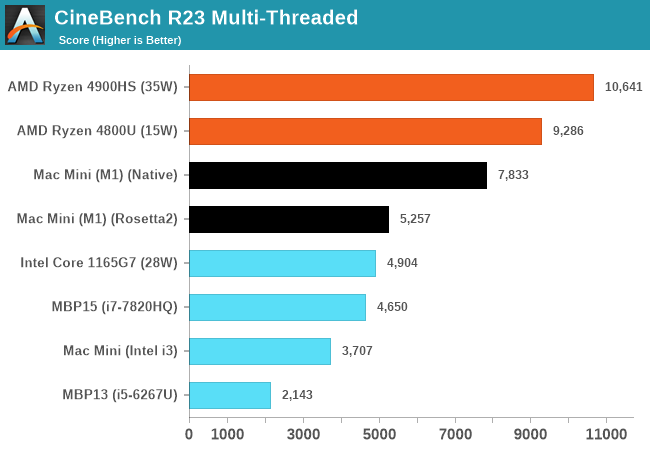
In the multi-threaded R23 runs, the M1 absolutely dominates past Macs with similar low-power CPUs. Just as of note, we’re trying to gather more data on other systems as we have access to them, and expand the graph in further updates of the article past publishing.
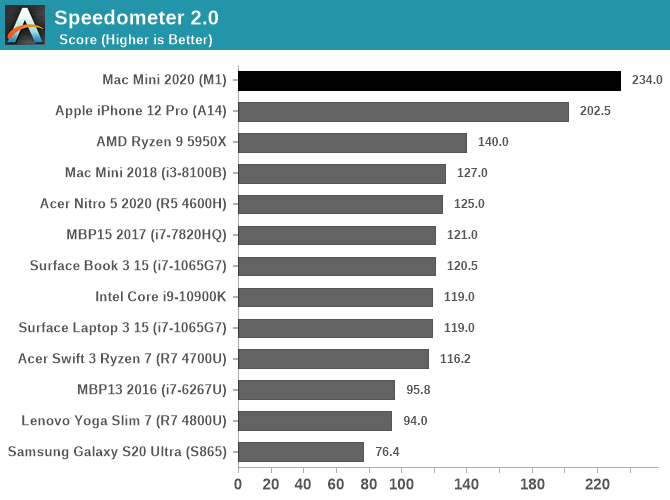
In browser-benchmarks we’ve known Apple’s CPUs to very much dominate across the landscape, but there were doubts as to whether this was due to the CPUs themselves in the iPhone or rather just the browsers and browser engines. Now running on macOS and desktop Safari, being able to compare data to other Intel Mac systems, we can come to the conclusion that the performance advantage is due to Apple’s CPU designs.
Web-browsing performance seems to be an extremely high priority for Apple’s CPU, and this makes sense as it’s the killer workload for mobile SoCs and the workload that one uses the most in everyday life.
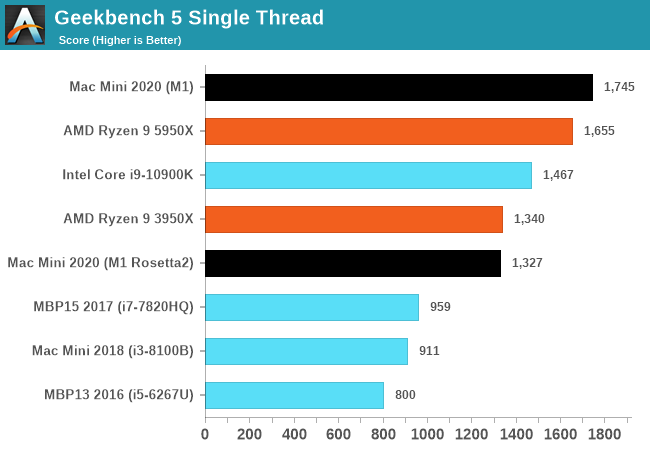
In Geekbench 5, the M1 does again extremely well as it actually takes the lead in our performance figures. Even when running in x86 compatibility mode, the M1 is able to match the top single-threaded performance of last generation’s high-end CPUs, and vastly exceed that of past iterations of the Mac mini and past Macbooks.
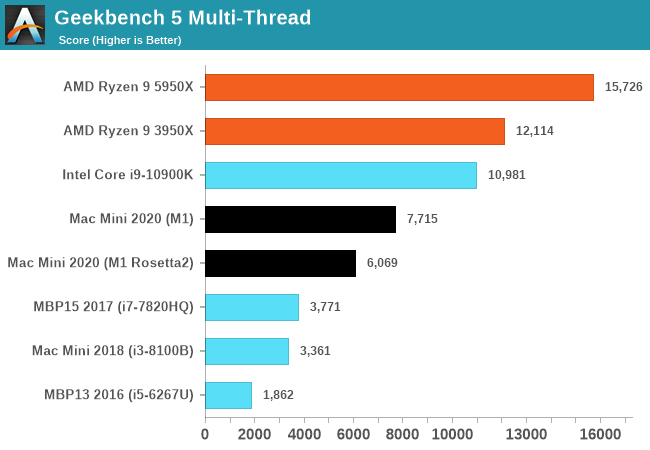
Multi-threaded performance is a matter of core-count and power efficiency of a design. The M1 here demolishes a 2017 15-inch Macbook Pro with an Intel i7-7820HQ with 4 cores and 8 threads, posting over double the score. We’ll be adding more data-points as we collect them.


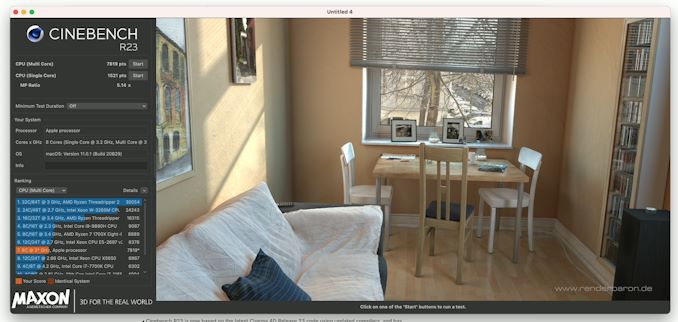








682 Comments
View All Comments
Soul_Master - Tuesday, November 17, 2020 - link
For Cinebench r23, you cannot directly compare between macOS and Windows. In Deve2D video, he already compared between Intel/M1 on the same macOS platform. Score of intel CPUs are significantly lower than Windows platform.https://www.youtube.com/watch?v=XQ6vX6nmboU&fe...
realbabilu - Wednesday, November 18, 2020 - link
i will checked using my hackintosh. running all worlds.Dug - Tuesday, November 17, 2020 - link
Impressive launch.I was expecting Rosetta to cripple it, but they've done a great job.
The fact that this is such low power and high performance, and even benchmarked against desktop cpu's, speaks volumes.
RedGreenBlue - Tuesday, November 17, 2020 - link
Woot! Finally. After waiting over 5 years for them to do this and explaining to people the prowess of the ARM microarchitecture’s ability in Apple engineers’ hands, it’s finally done.RedGreenBlue - Tuesday, November 17, 2020 - link
I still expect an 8+4 CPU design for higher thermal and power envelopes. They got this far. Might as well rub it in.Leeea - Tuesday, November 17, 2020 - link
Those rosetta emulation results are very impressive.They really knocked this one out of the park.
People are proclaiming this to be the death knell of x86, but it is to soon for that. However, in the expensive low power laptop segment they are the clear winner.
However, the only thing keeping the x86 laptops in the running was multithreading and discrete gpu's. Nothing stopping Apple from adding their own discrete gpu.
ABR - Wednesday, November 18, 2020 - link
Please add the Macbook Pro 16 to the comparisons, and drop the old 15.RSAUser - Wednesday, November 18, 2020 - link
"Naturally, in higher power-level, higher-core count systems, the M1 can’t keep up to AMD and Intel designs, but that’s something Apple likely will want to address with subsequent designs in that category over the next 2 years."That comment is very strange, that would be a completely different chip design. ARM excells at <20W, x64 excels at 30W+ with lots being ~45-60W sweet spot. They're competing in different markets.
scottrichardson - Wednesday, November 18, 2020 - link
This is what I'm interested in seeing too - how Apple scales these chips up with higher clock speeds, higher TDP, and larger memory pools.Spunjji - Thursday, November 19, 2020 - link
The theory goes that because Apple now have a core design that can compete with Intel and AMD's single-thread performance, if they can put more of them together, they'll also compete with those company's multi-thread performance.It depends a lot on how well their core design scales up in terms of inter-core communication fabric and memory access, but in theory, they could compete with AMD's 105W 7nm 16-core chips just by bolting 12 more large cores onto this - with a resulting TDP in the 80W region.
Whether they can get one of those out before AMD gets out their own 5nm chips is another matter entirely.